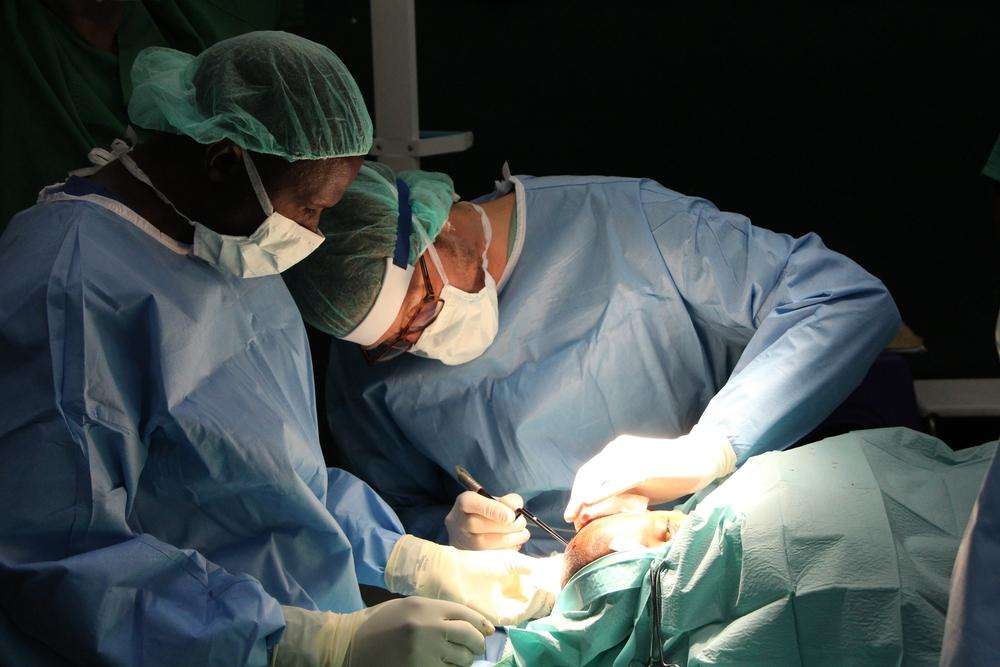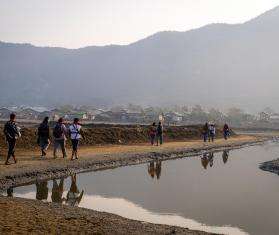Doctors Without Borders/Médecins Sans Frontières (MSF) has held its first surgical intervention in Nigeria for people with noma, a disfiguring and often deadly infection that mainly affects young children. In late August, 19 patients at the Noma Children's Hospital in Sokoto, northwestern Nigeria, underwent reconstructive surgery that will improve their health and their chances of re-entering society and living a normal life.
Most patients suffering from noma are children under the age of six, whose immune systems have been weakened by malnutrition, often in conjunction with measles. “Noma is caused by poor oral hygiene, and exacerbated by severe malnutrition commonly associated with extreme poverty,” says Agatha Bestman, MSF medical coordinator in Nigeria.
The disease begins as an ulcer inside the mouth. The ulcer becomes gangrenous, and, as it grows, it destroys facial bones and soft tissue. Left untreated, the disease is fatal in up to 90 percent of cases. Yet despite its severe consequences, and the fact that it is relatively common in less-developed countries, and especially in sub-Saharan Africa, noma is not widely known and receives little public attention.
MSF’s surgical team arrived to find more than 30 prospective patients waiting in Sokoto. The team selected 19 people for reconstructive surgery, based on the complexity of their condition, their overall health, and the time available. Nine patients underwent two rounds of surgery.
Okole Chukwumalinje , aged 46, had been on the waiting list for surgery since January 2014. “I am grateful I was selected for surgery,” said Chukwumalinje. “I am hoping that if the treatment is successful I can start a new life and become a missionary.”
Okole Chukwumalinje's Story
Okole Chukwumanige’s story is unique in many ways. He contracted noma as a toddler and beat the odds by surviving the disease. At age 46, he is the oldest patient currently being treated by the MSF team at the Noma Children’s Hospital in Sokoto, western Nigeria. He also traveled the furthest to get there, journeying 800 kilometers (nearly 500 miles) from southeastern Nigeria to Sokoto after 19 months on the waiting list for surgery.
Okole's face has been severely disfigured by noma, but when asked about stigmatization—a constant challenge faced by noma patients—Okole says, “I have never experienced such a thing.” Although his facial appearance can be unsettling to strangers, Okole says he has never been treated badly because of the way he looks. But Okole is still hopeful that the reconstructive surgery will improve his looks. He says, “Every time I see myself in the mirror, I don't experience any joy.”
Okole has had one round of surgery and will undergo a further round of reconstructive surgery early next year. Once his treatment is completed, Okole hopes to make a fresh start. “I am hoping that if the treatment is successful I can start a new life and become a missionary,” he says.
MSF’s team was made up of a plastic surgeon, a maxillofacial surgeon, an anesthesiologist, an anesthetic advisor, a nurse anesthetist, and an operating room nurse, who traveled to Nigeria from Germany, the Netherlands, and Zimbabwe. They worked in conjunction with MSF’s Noma project team in Sokoto and staff at the noma hospital.
“Noma creates deep holes in the face, which can make normal activities like eating very difficult,” says MSF surgeon Dr. Hans De Bruijn. Surgery corrects the problem. “A noma surgery can last as long as six hours,” says Dr. De Bruijn. “In some cases, all that is needed is a skin graft. In others, we may have to reconstruct parts of the face.”
Aisha Danyaya's Story
“I want the surgeons to repair my face so that I can get married,” says 15-year-old Aisha Danyaya softly. She is among a group of noma patients and caregivers talking with MSF psychosocial support counselors at the Noma Children’s Hospital in Sokoto, western Nigeria.
Like many girls her age in rural Nigeria, Aisha is preoccupied with marriage, but worries that her dream may not be possible due to the effects of noma. She is missing half of her lip and nose, and she fears that the damage done to her face will put off potential suitors.
Despite the physical effects of the disease, Aisha has coped well. She runs a small business in her village selling foodstuffs. Here in the hospital, she is shy and usually speaks in a voice barely above a whisper.
One week into the MSF team’s visit, Aisha has had two operations: the first to remove tissue from her forehead; the second to use the same tissue to reconstruct the damaged part of her face. She is now recovering and waiting for a third operation—this time very minor—which will be performed by a local surgeon. After that she will be able to return to her village and look forward to the future with renewed optimism.
Prior to surgery, an MSF mental health team worked with patients and their caregivers to build their trust, support them in speaking with medical staff, and help them understand the complicated medical procedures associated with noma surgery. The team also worked with younger patients to help them develop social skills they may have missed out on, as patients suffering from noma are often shunned by society. “Supporting a young person and their family to overcome the emotional impact of the disfigurement is a core part of the counseling,” says MSF clinical psychologist Thomas Hoare.
Those noma patients who were not selected for surgery this time around will have another chance to have facial reconstructive treatment when MSF holds its next surgical intervention in Sokoto in early 2016. Going forward, MSF plans to hold noma surgeries in Sokoto four times a year.
Read More: Helping Noma Patients Face Their New Lives





